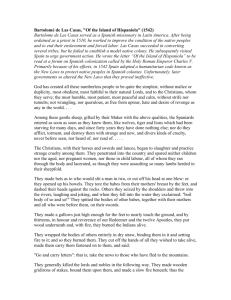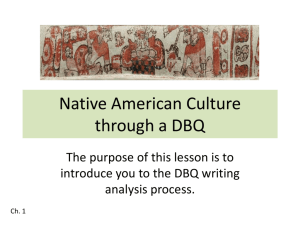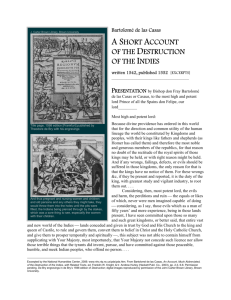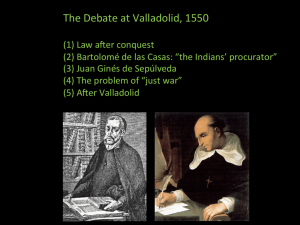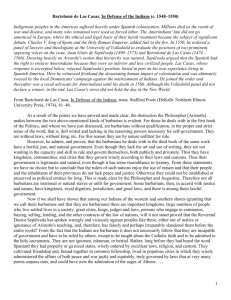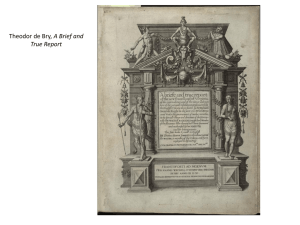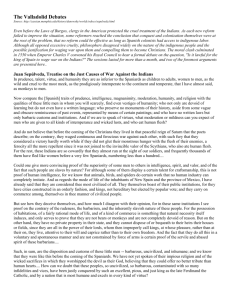Bartolome de Las Casas: The Eternal Gaurdian of the Indians by
advertisement
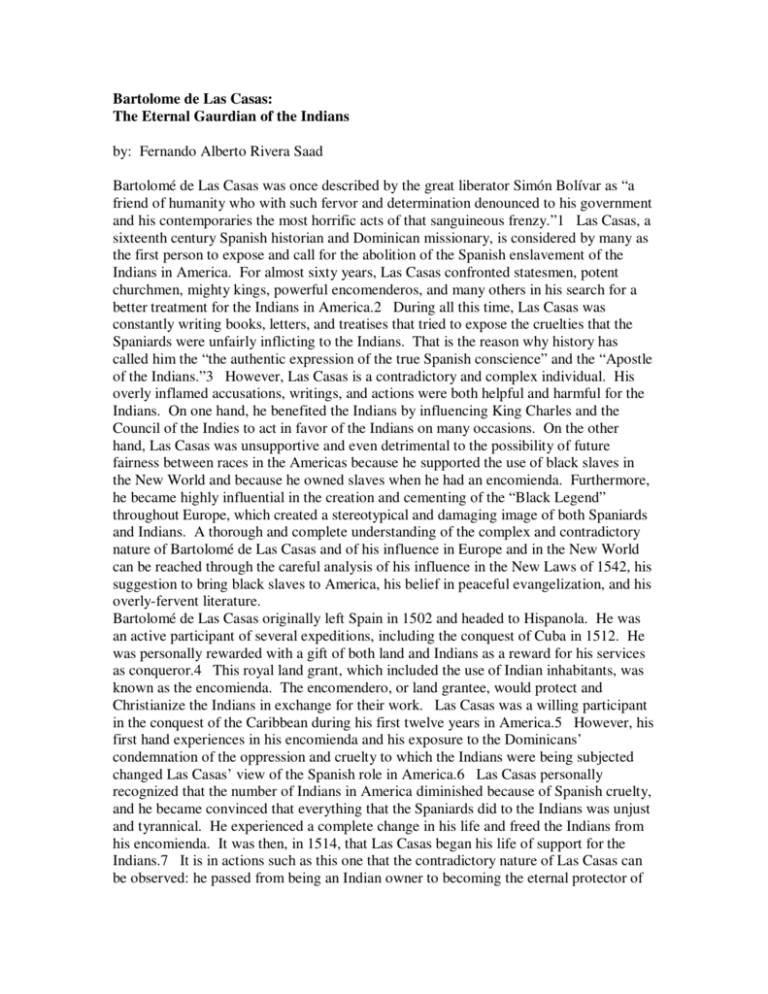
Bartolome de Las Casas: The Eternal Gaurdian of the Indians by: Fernando Alberto Rivera Saad Bartolomé de Las Casas was once described by the great liberator Simón Bolívar as “a friend of humanity who with such fervor and determination denounced to his government and his contemporaries the most horrific acts of that sanguineous frenzy.”1 Las Casas, a sixteenth century Spanish historian and Dominican missionary, is considered by many as the first person to expose and call for the abolition of the Spanish enslavement of the Indians in America. For almost sixty years, Las Casas confronted statesmen, potent churchmen, mighty kings, powerful encomenderos, and many others in his search for a better treatment for the Indians in America.2 During all this time, Las Casas was constantly writing books, letters, and treatises that tried to expose the cruelties that the Spaniards were unfairly inflicting to the Indians. That is the reason why history has called him the “the authentic expression of the true Spanish conscience” and the “Apostle of the Indians.”3 However, Las Casas is a contradictory and complex individual. His overly inflamed accusations, writings, and actions were both helpful and harmful for the Indians. On one hand, he benefited the Indians by influencing King Charles and the Council of the Indies to act in favor of the Indians on many occasions. On the other hand, Las Casas was unsupportive and even detrimental to the possibility of future fairness between races in the Americas because he supported the use of black slaves in the New World and because he owned slaves when he had an encomienda. Furthermore, he became highly influential in the creation and cementing of the “Black Legend” throughout Europe, which created a stereotypical and damaging image of both Spaniards and Indians. A thorough and complete understanding of the complex and contradictory nature of Bartolomé de Las Casas and of his influence in Europe and in the New World can be reached through the careful analysis of his influence in the New Laws of 1542, his suggestion to bring black slaves to America, his belief in peaceful evangelization, and his overly-fervent literature. Bartolomé de Las Casas originally left Spain in 1502 and headed to Hispanola. He was an active participant of several expeditions, including the conquest of Cuba in 1512. He was personally rewarded with a gift of both land and Indians as a reward for his services as conqueror.4 This royal land grant, which included the use of Indian inhabitants, was known as the encomienda. The encomendero, or land grantee, would protect and Christianize the Indians in exchange for their work. Las Casas was a willing participant in the conquest of the Caribbean during his first twelve years in America.5 However, his first hand experiences in his encomienda and his exposure to the Dominicans’ condemnation of the oppression and cruelty to which the Indians were being subjected changed Las Casas’ view of the Spanish role in America.6 Las Casas personally recognized that the number of Indians in America diminished because of Spanish cruelty, and he became convinced that everything that the Spaniards did to the Indians was unjust and tyrannical. He experienced a complete change in his life and freed the Indians from his encomienda. It was then, in 1514, that Las Casas began his life of support for the Indians.7 It is in actions such as this one that the contradictory nature of Las Casas can be observed: he passed from being an Indian owner to becoming the eternal protector of the Indians. His new inspiration and purpose in life made him return to Spain in 1515; he had realized that it was useless to try to defend the Indians while being so far away from Spain. In Spain, Archbishop Francisco Jiménez de Cisneros aided Las Casas in creating a plan to reform the Spanish handling of the Indies. Las Casas was appointed to a commission that would investigate the status of the Indians. He used the results of his investigation to propose a plan in which Spaniards and free Indians would join to create a new type of society in America. Las Casas tried out his experiment in Cumaná, Venezuela, but it unfortunately failed.8 His experiment of creating a semi-utopic society failed mostly because instead of giving him the Spanish farmers that he asked for, the Crown gave him about two hundred lazy, alcoholic, and criminal Spaniards. Many of these men escaped from the ships in the several ports that Las Casas’ expedition went through before reaching its final destination, Cumaná. He had imagined a society in which Indians and Spaniards would farm together, but his Spanish men were not hard workers at all.9 One of the most controversial and contradictory periods of Las Casas’ life occurred while he had been preparing for the Cumaná experiment. In 1516, he asked the king in his Memorial de Remedios (Memorial of Remedies) to give him and other Spaniards about twenty slaves each in order to maintain the mines in America.10 Las Casas was following the accepted system of slavery at that time, in which both black and white people served as slaves in Spain. Las Casas actually asks for these slaves because he feels that people who were already slaves in Spain should be used to replace the Indians, whose legal regime was that of freedom. Las Casas also asked for shipment of black slaves in the years of 1518, 1531, and 1543. These instances of proposing black slavery have been the issue most widely reproached in the life of Las Casas. However, petitions for slavery were very common in those times and had been made by hundreds of friars, laymen, and officials; and Las Casas was definitely not the only one to propose it. It is very important to make it clear that Las Casas is by no means the founder of black slavery in the Indies.11 We must remember that when Las Casas asks for black slaves, “he does so from within a prevailing system (this does not remove its profound injustice) that was accepted socially and justified philosophically and theologically at the time.”12 It is also important to remember that Las Casas asked only for black men who were already slaves in Spain, and he did so in small quantities.13 Nonetheless, Las Casas did support and in a way sanctioned the enslavement of a group of people that were as oppressed as the Indians that he so fervently defended. Actions such as this provide further proof of the contradictory and conflicting nature of Las Casas. He is defending some from oppression by asking for others to be oppressed. After his request for slaves in 1543, Bartolomé de Las Casas began to repent for the blindness in which he had been when he requested the shipment of black slaves. It was around that time that he visited Lisbon and found out what was going on in Africa in respect to the manner in which Africans were being captured and enslaved. Las Casas now saw the injustice of black slavery and started writing about it. He was now convinced that the enslavement of blacks was as unfair as that of the Indians; this was reflected in his writings when he used the same terms to speak about both groups of people.14 Las Casas fiercely denounces the Portuguese, who had been using the European war against Islam as a way to conceal their lucrative trade of innocent Africans that were being captured on the Guinea coast. Las Casas thus became the first person of his time and the only one of his century to denounce the slavery of Africans and the cruelty and immorality of the traffic of slaves.15 After analyzing the unfairness of slavery, he deeply repents for his past actions and suggestions. In his History of the Indies, Las Casas says the following about himself: When the cleric Las Casas first gave that advice—to grant the license to bring Black slaves to the islands—he was not aware of the unjust ways in which the Portuguese captured and made slaves of Blacks. But after he found out, he would not have proposed it for all the world, because Blacks were enslaved unjustly, tyrannically, right from the start, exactly as the Indians had been.16 As can be observed here, Las Casas deeply regrets and laments having been part of the unjust traffic of black slaves. His concept of African slavery had changed completely, and he now viewed the captivity of blacks as one that was as morally wrong as that of the Indians. He sees them both as the suffering sons of God, and he ponders whether divine justice will ever forgive him for having been part of black slavery.17 His remorse is evident and sincere, and it cannot be doubted. After the unsuccessful experiment at Cumaná, Las Casas took refuge in a religious life. In 1523, he joined the Dominican order, which would later become one of his strongest supporters. Four years later, he began writing the Historia Apologética, which later served as an introduction to his History of the Indies. This is an account of what happened in America under the Spanish rule as Las Casas had seen it or as he had heard of it. Las Casas intention in writing this book was to reveal how the sins of domination, oppression, and injustice would later be the reason for God’s punishment of Spain.18 Las Casas interrupted his work on History of the Indies to send three letters to the Council of the Indies in Madrid, in order to accuse the encomienda system and the encomenderos of the sin of oppressing the natives. Las Casas was convinced that the only way to convert the Indians was to use peaceful evangelization. He set out his ideas in his work Concerning the Only Way of Drawing All Peoples to the True Religion. In this work, Bartolomé criticizes the view of his opponents, who believe that “it would be quicker and better done if they subjected pagans willy-nilly to Christian political power. Once the pagans were beaten, they could be preached to without trouble.”19 Las Casas totally disagrees with this concept of using war and violence in order to indoctrinate the Indians. Bartolomé firmly believed that this method violated the Indian’s right to life and liberty that they deserved as the sons of God. Furthermore, he does not view peaceful evangelization as merely the best way of preaching the Christian faith, but as the only way to do so.20 Even though this sounds obvious to us to today, we must remember that Las Casas’ views challenged and opposed the general beliefs of his century. In his Carta al Consejo de Indias (Letter to the Council of the Indies), which was written before The Only Way, Las Casas recalls what Christ commanded his successors to do relating to the preaching of the Christian doctrine: Make the gift of his peace, do good to all, and, with the sweetness of their virtues and good works, give freely of what they had freely received, endeavoring to exert an attraction—as our forebears were attracted to good works by peace and love. 21 Las Casas is recalling Christ’s message in order to set an example of how he thinks evangelization should be. The passage makes it clear that Jesus wanted peaceful and loving evangelization, and Las Casas was determined to achieve this. He later says in The Only Way that Jesus was clear when he taught that humans should be good to all, especially to those individuals in greatest need. After all, the image of a peaceful evangelization is in total unity with our image of God as the “Father of mercies.”22 By following his own guidelines as stated in The Only Way, Las Casas and several Dominicans headed to the Verapaz region in present-day Costa Rica in order to attempt to convert the Indians who lived there. Verapaz was a “land of war,” which meant that it was inhabited by unconquered Indians.23 Here, Bartolomé and the Dominicans preached the Christian faith and gave the Indians the time and freedom of choice that they believed the Indians deserved. Without violence or any form of weapons, they were able to convert the vast majority of the Indians of Verapaz.24 The highly favorable outcome of this experiment encouraged Las Casas to return to Spain in 1539. There, he requested an audience with King Charles, who had been elected Holy Roman Emperor Charles V in 1519, and wrote A Brief Account of the Destruction of the Indies.25 This book is probably the bitterest protest ever written against the injustice of the Spanish colonization and conquest of the Americas.26 Las Casas was so insistent about having an audience with Charles V that the king called a meeting of jurists and theologians in Valladolid in 1542 to please him. There, Las Casas used the arguments developed in his recently written A Very Brief Account of the Destruction of the Indies to expose to Charles V and everyone present in the meetings all of the unfairness that was occurring in America. Las Casas’ cause won the favor of King Charles; he signed the Leyes Nuevas (New Laws). In fact, Charles V was so impressed by Las Casas’ arguments that he even seemed willing to abandon the Indies, but Francisco Vitoria dissuaded him by saying that the Spanish retreat from the Indies would profoundly damage the Indians that had already been converted to Christianity.27 Las Casas was a reformer in his time; through his protection of the Indians and his support for the New Laws, Las Casas was attempting to restructure the whole socio-economic condition of the Indies. This is not the only aspect of European domination of the Indies that Las Casas was trying to reform; he was also opposing the people in the highest positions of the church hierarchy. According to the “Requerimientos” (“Notifications”), documents written in 1513 to justify the Spanish domination of the Indians, the Pope donated all the mainland and islands in the Indies to the kings of Spain. Furthermore, the “Notifications” state that this donation by the Pope makes the kings of Spain the lords and superiors of the Indians. The “Notifications” were written by the royal councilor Palacios Rubios, who based the document on the teachings of Pope Innocent IV and on Enrique de Susa, Cardinal of Ostia. Las Casas and the New Laws that he helped to bring about are clearly fighting against powerful religious, economic, and political authorities.28 The major change brought by the New Laws of 1542 was that they stated that the encomienda was not going to be hereditary. This meant that encomenderos would therefore have to set their Indians free after the span of a single generation.29 Some of the provisions regarding the encomienda can be appreciated in the following excerpt from the New Laws: In the same fashion, the Audiencias are to find out how the Indians have been treated by the people who have held them in the encomienda. If it is evident to the Audiencias that the encomenderos should be deprived of their Indians due to the abuse and bad treatment they have meted out to them, we order that the Audiencias take the Indians away… [whenever] the encomendero of said Indian dies, they are to be placed under our royal crown.30 As can be observed here, the New Laws were trying to prevent abuses against Indians in encomiendas immediately and were trying to abolish the whole institution of the encomienda gradually, as the generation that presently owned it died. Bartolomé battled against the encomienda throughout his whole life; historian and biographer Gustavo Gutiérrez believes that if Las Casas had not combated encomiendas so doggedly as he did, the additional corruption that would have resulted from them would be even greater. Furthermore, Las Casas identified the cause of the evil as being the system itself and not the personal excesses or abuses. The whole socioeconomic system was sinful to Las Casas. The encomenderos justified themselves by appealing to the concept in the “Notifications” that said that Indians were inferior to the Spaniards, but Bartolomé aggressively fought this by saying that the both Indians and blacks were the poor mentioned in the gospels.31 The New Laws also addressed many other issues besides the encomiendas. First, it ordered that Indians be treated as free vassals of Spain and that they be instructed in the Christian faith peacefully. Second, it prohibited explorers from taking Indians out of their lands or islands unless they were absolutely indispensable as interpreters or translators. Third, they declared that the Indians of the islands of San Juan, Cuba, and the Hispanola could not be taxed or forced to pay tribute greater than those imposed on the Spaniards who live in the same islands as they do. Most importantly, the New Laws made it clear that no Indian could be enslaved for any reason whatsoever. Neither war nor rebellion nor trade constituted a valid reason to enslave an Indian.32 Las Casas was extremely glad with the passing of the New Laws, but he was a realist deep inside and harbored few illusions about the consequences that they would have in the Indies. After all, his many years of hard struggle had taught him that legal norms were only followed in America if they did not run against the privileges of the encomenderos and colonists.33 Nonetheless, Las Casas was determined to fight for the enforcement of the New Laws and to look for mechanisms to make them work.34 The Court offered Las Casas the position of Bishop of Chiapas in Guatemala in order to guarantee the enforcement of the Leyes Nuevas, and he accepts it.35 His rigorous and uncompromising attitudes won him much opposition, however.36 Encomenderos fiercely and violently opposed the New Laws; their reaction was so pronounced that Charles V, who had been a supporter of the New Laws until now, revoked some of the most essential parts of them. The clause canceling the hereditary character of the encomienda was one of those clauses revoked. Charles V even issues a Provision in 1545, in which he states that the conditions of the encomienda in America were to return to the way they were at the time previous to the emission of the New Laws.37 As always, adversity sharpened Las Casas’ understanding of the situation and strengthened his determination. That is why he returned to Spain again in 1547 in order to attempt to win more royal support. This period in Spain became one of the most fruitful periods in his life-long pursuit of Indian rights. Las Casas reached Spain and finds a Spanish monarchy that is facing serious fiscal difficulties. 38 The new king, Philip II, had inherited an unfinished war with France from his father, Charles V. This and many other wars that were shaking Europe in the sixteenth century left Spain with a debt of over 20 million ducats. 39 Taking advantage of this economic situation, the encomenderos of Peru and other parts of America had sent tempting proposals to the financially debilitated Spanish monarchy in their attempt to make the encomiendas a perpetual institution. The Crown was seriously considering this idea; the accord declaring the perpetuity of the encomienda was about to be signed by King Phillip II and by the encomenderos when Las Casas intervened. He used all his energy to convince the king and other influential people about the drastic consequences of this socioeconomic system. He blamed the encomenderos for the depopulation of the Americas and made it clear that the poverty-stricken and oppressed Indians which he sees in the encomiendas are not the same persons that existed before the conquest of the Indies. He makes the king change his mind about declaring the encomiendas a perpetual institution by pointing out to him that the greedy and ambitious encomenderos were destroying his most valuable possession in the New World: the Indians.40 Las Casas achieves his goal of avoiding the perpetuity of encomiendas, but he does so by qualifying the Indians as “things”. This view of them as possessions is inconsistent with his usual classification of them as humans. His contradictory nature is thus revealed again. It was during this period in Spain too that Las Casas became an important and influential part of the Council of the Indies. The reason why Las Casas became so influential in this institution lies in his education. Before becoming a religious, Bartolomé had received a degree of Licentiate in Canon Law in Valladolid in 1519.41 Therefore, Las Casas was an authority in both secular and ecclesiastical matters. Furthermore, his vast experience in the Indies made him more knowledgeable of any situation than almost any member of the Council of the Indies.42 It was also during this period in Spain that Las Casas came into direct confrontation with the prominent theologian Juan Ginés de Sepúlveda, the author of “Concerning the Just Cause of the War Against the Indians.”43 Sepúlveda was an important court figure that maintained that Indians “are inferior to Spaniards just as children are to adults, women to men, and, indeed, one might say, as apes are to men.”44 According to Sepúlveda, there were four reasons to justify war against the Indians in order to convert them. Sepúlveda based his ideas on the Aristotelian concept that war becomes justified when the natural condition of a group of people is such that they ought to obey others who are superior to them. First, Sepúlveda said that Indians were barbarous beings, and Las Casas rebutted him by saying that the Spaniards were displaying a more savage and thus barbarous behavior than the Indians. Also, he said that Sepúlveda’s point about Indians being barbarous because of their lack of written language was a misinterpretation of Aristotle’s concept of a barbarian.45 He further supports his point by saying the following: It would be impossible to find one whole race, nation, region, or country anywhere in the world that is slow-witted, moronic, foolish, or stupid, or not even having for the most part sufficient natural knowledge and ability to rule and govern itself.46 As can be seen, Las Casas makes it clear that the Indians are not barbarians as a whole. There might be a few barbarians amongst them, but, for the most part, the Indians are “intelligent, far sighted, diligent, and talented.”47 Furthermore, he adds that Aristotle says in his Politics that barbarians were to be gently persuaded and lovingly drawn to accept a new civilized world; they were never to be compelled harshly or violently. Thus he proves that Sepúlveda’s violent suggestion is erroneous, even if the Indians qualified as barbarians.48 Las Casas is using Aristotle to counterattack Sepúlveda because the Politics of Aristotle was the base of much of Sepúlveda’s arguments. Second, Sepúlveda argued that Indians committed crimes against the natural laws, so war was a justified punishment for their crimes. Las Casas attempted to invalidate this point by saying that punishments reflect jurisdiction over someone, but the Spaniards had none over the Indians. One of the natural crimes that Sepúlveda charged on the Indians was the worship of idols.49 Bartolomé defends the Indians in the following excerpt from his In Defense of the Indians: However, the worshippers of idols, at least in the case of the Indians, about whom this disputation has been undertaken, have never heard the teaching of Christian truth even through hearsay; so they sin less than the Jews or Saracens, for ignorance excuses to some small extent.50 Las Casas explains above that the Indians have never heard about Christianity, so they do not know anything about the Christian idea that worshipping idols is a sin. In a certain way, this makes their sin easily forgivable. Third, Sepúlveda said that Indians are oppressors and murderers of innocent people. He blamed Indians for engaging in human sacrifices to their gods and of being cannibals. Las Casas entered into a complicated and lengthy argument that tried to demonstrate that Sepúlveda’s assertions were erroneous. He says that even if they did sacrifice humans to their gods or ate them, this should be tolerated because it is better to put up with the deaths of a few innocent people sacrificed or eaten than to start a war against a large group of people among which one would kill many more innocents. Furthermore, Las Casas said that war against the Indians was likely to implant a hatred for Christianity in their heart, and this is definitely not something favorable to the spread of the Spanish religion.51 Sepúlveda’s fourth and last argument stated that war could and should be waged against the infidels in order to prepare the way for the preaching of the Christian faith. To support his argument, Sepúlveda had used the parable in the Bible where the Lord commands his servants to go to the highways and force people to come into a wedding feast.52 Las Casas used the following fragment from his In Defense of the Indians as part of his rebuttal of Sepúlveda’s fourth argument: At this point, I would like Sepúlveda and his associates to produce some passage from the sacred literature where the gospel parable is explained as he explains it; that is, that the gospel (which is good and joyful news) and the forgiveness of sins should be proclaimed with arms and bombardments, by subjecting a nation with armed militia and pursuing it with the force of war. What do joyful tidings have to do with wounds, captives, massacres, conflagrations, the destruction of cities, and the common evils of war? They will go to hell rather than learn the advantages of the gospel.53 Las Casas is exposing here his view that conversion will never occur through the violent means that Sepúlveda is suggesting. After all, Sepúlveda’s ways do not follow the Christian ideal of treating fellow men just as Christ treated his fellow men. According to Las Casas, Indians were rational humans who would convert to Christianity if Spaniards preached peacefully and with love. This would lead to real understanding of Christianity and to true conversions. This was better, after all, than the superficial baptism of the uninstructed that was taking place. Las Casas believed that the true justification of Spanish rule in the Indies was the peaceful conversion of the natives to the Christian faith rather than the blind lust for gold and profits that was driving many Spaniards.54 As can be seen, Sepúlveda’s reasoning justified the Spaniards cruel behavior towards the Indians in America; Las Casas’ confrontation with him in 1550 and 1551 greatly weakened Sepúlveda’s support, at least in the court. Behavior in America for the most part went unchanged. During the final years of his life, Las Casas became an important advisor to both the king and the Council of the Indies on many of the issues relating to the Indians. He continued defending his beloved Indians up to the day he died at the age of ninety-two. The viceroy of Peru, Francisco de Toledo, suggested to the king that all the works of Las Casas should be collected. Although this was done, his influence in Spain and in the Indies declined after his death. However, the several translations of A Very Brief Account of the Destruction of the Indies made him well known in many other parts of Europe. This book was a lasting and powerful indictment of the Spanish treatment of the Indians in America. The widespread circulation of The Destruction was permitted not only by its translations to English, French, and Dutch but also because the printing press aided in the publication of multiple copies of books. These factors helped to cement in Europe the socalled “Black Legend,” which is often attributed to Las Casas. The core of the Black Legend is made by two stereotypes for which Las Casas and The Destruction are mostly responsible. First, they created the image of the Indians as peaceful, childlike, and innocent individuals. Second, they presented Spaniards as cruel, rapacious, and self-centered individuals.55 This can be clearly appreciated in the following excerpt from The Destruction: God made all the people of this area, many and varied as they are, as open and as innocent as can be imagined. The simplest people in the world—unassuming, longsuffering, unassertive, and submissive—they are without malice or guile, and are utterly faithful and obedient both to their own native lords and to the Spaniards…. the Spaniards still do nothing save tear the natives to shreds, murder them and inflict upon them untold misery, suffering and distress, tormenting, harrying and persecuting them mercilessly. We shall in due course describe some of the many ingenious methods of torture they have invented and refined for this purpose.56 As can be seen, the adjectives that Las Casas uses to describe the Indians in this passage are all benevolent and caring: simple, innocent, submissive, faithful, and others. On the other hand, he presents the Spaniards who came to America as the ultimate form of evilness; they went so far as to invent punishments specifically to torture and torment the Indians. It can be clearly appreciated here that Las Casas wrote with passion, and this caused his writings to lack objectivity and impartiality. Many historians and critics have cited this as being one of the major flaws in Las Casas’ literature. Las Casas wanted to protect the Indians from suffering under the Spaniards, and he used any argument at hand in order to support his view of the unmerciful and cruel Spanish behavior.57 The Destruction was highly effective in making Las Casas’ view widespread for several reasons. First, the English and other Europeans eagerly accepted it because it became a perfect excuse to justify their conquest of America. The English especially used the Spanish cruelty and injustice as reflected in The Destruction to prove their point that America needed a conqueror such as them because they had a proud legacy of civil and religious liberty.58 Furthermore, for Protestant England, the literature of Las Casas provided a catalogue of the injustices and evil actions inflicted by Catholic Spain on the innocent and vulnerable Indians. This of course called for a greater non-Spanish presence of Europe in the New World.59 The aspect that made the literature of Las Casas so powerful was that it was the criticism of an insider, a Spanish Catholic priest, and the criticism of an insider is by far more powerful and appealing than any criticism from an outsider.60 The second reason why The Destruction was so widely accepted in Europe was because the basic premise of most of the arguments of this book is the idea that legitimate secular power does exist outside of the church. Las Casas strongly supported the view that the Indians’ legitimate dominium was just and lawful; therefore, the Spanish Crown and the Spanish people had no right to take away the Indians’ just title. Las Casas’ arguments about this issue were unimpeachable because he supported them with the legal opinions of three centuries. Furthermore, The Destruction also appealed to ecclesiastical law to prove its points, and ecclesiastical law had a large role in the Catholic Spain of the midsixteenth century.61 Third, the highly appealing nature of The Destruction was also due to the fact that Las Casas described in a detailed and in a highly exaggerated manner the way that the Spaniards inflicted pain on the Indians. This can be appreciated in the following fragment: One of his officers was responsible for the indiscriminate slaughter of many locals, hanging some, burning others alive, and throwing yet others to wild dogs, sometimes sawing of their hands and feet, sometimes pulling out their tongues or hacking off their heads. Even though the locals never raised a finger against the Spaniards, the distinguished commander knowingly allowed this spate of atrocities to continue unchecked.62 As can be appreciated, Las Casas makes his readers feel profound pity and compassions for the defenseless Indians who are subjected to bloody and painful tortures by the ruthless and brutal Spaniards. At the same time, a feeling of hatred and repulsion for the cruel Spaniards is awoken in the reader. This created lasting images in the minds of Europeans, and the view of Spaniards as exterminators and exploiters had been established. The “Black Legend” can still be seen in the world today. It is common today to find Americans who have the misconception that the English came to settle America while the Spaniards only came to exploit the land and its inhabitants in order to search for gold.63 This is just an indicator of how enduring Las Casas’ views have proven to be. This has not only proven prejudicial to the Spaniards but also to the Indians. After all, Las Casas perpetuated the image of a childlike, frail, and vulnerable Indian. Therefore, most of the Europeans that conquered America viewed the Indians in this way and believed that they needed a superior race to guide them and shield them from harm. Involuntarily, Las Casas had been of key importance to the creation of a stereotype of the Indians that facilitated their abuse under the rule of different European nations. Bartolomé de Las Casas was definitely the most fervent and influential advocate of Indian rights during his time. Las Casas lived during a period in which Spain was conquering the New World, and the conquistadors and the subsequent encomenderos viewed the Indians as natural slaves and as barbarians. This of course left the Indians as a group of people that was totally deprived of voice and denied the right to plead their own liberty and innocence before any court. A humane and compassionate man, Las Casas became their voice and their protector. As his understanding of the difficulty of his goal increased, Las Casas started writing about the cruelty of the Spaniards to the innocent Indians. The major results of his writings and his pleas to the court were the passing of the New Laws of 1542 and the cementing of the Black Legend throughout Europe. Even when many claim that Las Casas had no lasting impact on the colonial policies of Spain, his cultural influence at a less immediate level were immense and beyond doubt.64 The influence and role of Las Casas in his society can be compared to that of the ancient Athenian philosopher Socrates: they are both the gadflies of their societies. After all, Las Casas was the moral conscience of expanding Spanish empire; he was always reminding the Spanish and the Europeans of the injustices that were being committed by his country on the Indians of the New World. However, his actions and writings were not solely beneficial for the Indians. We must remember that he once owned Indians in his encomienda, supported African slavery during his early life, and helped to create a prejudicial, stereotypical image of the Indians. Nonetheless, it can safely be said that his positive intentions and actions greatly outweigh those negative ones. Bartolomé de Las Casas has definitely marched into history as “the authentic expression of the true Spanish conscience” and as the “Apostle of the Indians.”65 Notes 1 Anthony Pagden, “Introduction” to A Short Account of the Destruction of the Indies, Bartolomé de Las Casas, trans. Nigel Griffin, (New York: Penguin, 1992), p. xiii. 2 Sir Arthur Helps, The Life of Las Casas: The Apostle of the Indies (London: George Bell and Sons, 1896), p. xiv. 3 Pagden, p. xiii and Helps, p. vii. 4 Lewis Hanke, Bartolomé de Las Casas: Bookman, Scholar & Propagandist (Philadelphia: University of Pennsylvania Press, 1952), p. 38. 5 Encyclopædia Britannica Inc., “Bartolomé de Las Casas,” Encylopædia Britannica (1994), <http://www.britannica.com>, 4 November 2000. 6 Gustavo Gutiérrez, Las Casas: In the Search of the Poor of Jesus Christ, trans. Robert R. Barr, (Maryknoll: Orbis Books, 1992), p. 51. 7 Hanke, Bookman, Scholar & Propagandist, p. 39. 8 Encylopædia Britannica. 9 “Fray Bartolomé de las Casas en Venezuela,” Dominicos Venezuela (1998), <http:// www.iglesia.org.ve/dominicos/temas/tema6/tema6.htm>, 4 November 2000. 10 Gutiérrez, p. 324. 11 Gutiérrez, pp. 324-5. 12 Gutiérrez, p. 325. 13 Gutiérrez, pp. 325-6. 14 Gutiérrez, pp. 326-7. 15 Bartolomé de Las Casas, Indian Freedom: The Cause of Bartolomé de las Casas, trans. and ed. Francis Patrick Sullivan, (Kansas City: Sheed & Ward, 1995), p. 160. 16 Bartolomé de Las Casas, History of the Indies, qtd. from Indian Freedom: The Cause of Bartolomé de las Casas, p. 160. 17 Gutiérrez, p. 327. 18 Encylopædia Britannica. 19 Bartolomé de Las Casas, Concerning the Only Way of Drawing All Peoples to the True Religion, qtd. from Gutiérrez, p. 159. 20 Gutiérrez, p. 159. 21 Bartolomé de Las Casas, Carta al Consejo (Letter to the Council of the Indies), qtd. from Gutiérrez, p. 160. 22 Gutiérrez, pp. 160-1. 23 Encylopædia Britannica. 24 Gutiérrez, p. 165. 25 Encylopædia Britannica. 26 Pagden, p. xiii. 27 Percy Rachid Assen, “Derecho Indiano,” Assen: Red Juridica Peruana, 30 July 1997, <http://www.guia happy.com/assen/indio.htm>, 4 November 2000. 28 Gutiérrez, pp. 110-11. 29 Gutiérrez, p.14. 30 “New Laws,” qtd. from Indian Freedom: The Cause of Bartolomé de las Casas, p. 251. 31 Gutiérrez, p. 14. 32 Las Casas, Indian Freedom, pp. 249-52. 33 Gutiérrez, p.553. 34 Gutiérrez, p.553. 35 Gutierrez, p. 289. 36 Encylopædia Britannica. 37 Gutiérrez, pp. 288-89 and p. 553. 38 Gutiérrez, p. 290-91. 39 Encylopædia Britannica. 40 Gutiérrez, pp. 290-91. 41 A licentiate is an academic degree given by some European universities that ranks below that of doctor. 42 Gutiérrez, p. 400. 43 This text was so influential because Sepulveda wrote it under a special commission from the Pope. 44 Juan Gines de Sepulveda, qtd. from Encylopædia Britannica. 45 Lewis Hanke, All Mankind is One: A Study of the Disputation Between Bartolomé de Las Casas and Juan Gines de Sepulveda on the Religious and Intellectual Capacity of the American Indians (DeKalb: Northern Illinois University Press, 1974), p. 87. 46 Bartolomé de Las Casas, In Defense of the Indians: The Defense of the Most Reverend Lord, Don Fray Bartolomé de Las Casas, of the Order of Preachers, Late Bishop of Chiapa, Against the Persecutors and Slanderers of the Peoples of the New World Discovered Across the Seas, trans. Stafford Poole, (DeKalb: Northern Illinois University Press, 1992), p. 38. 47 Las Casas, In Defense, p. 38. 48 Las Casas, In Defense, pp. 38-9. 49 Hanke, All Mankind is One, p. 87. 50 Las Casas, In Defense, p. 78. 51 Hanke, All Mankind is One, pp. 89-92. 52 Hanke, All Mankind is One, p. 95. 53 Las Casas, In Defense, p. 270. 54 Hanke, Bookman, Scholar & Propagandist, pp. 30-1. 55 “Viewers & The Viewed: Black Legends,” Cultural Readings: Colonization and Print in the Americas (07 January 1998), <http://www.library.upenn.edu/ special/gallery/kislak/viewers/black.html>, 4 November 2000. 56 Bartolomé de Las Casas, A Short Account of the Destruction of the Indies, trans. Nigel Griffin, (New York: Penguin, 1992), pp. 9-11. 57 Kenneth Pennington, “Bartolomé de Las Casas and the Tradition of Medieval Law,” History 381/615: Foundations of Modern Law, <http://classes.maxwell. syr.edu/His381/LasCasas2.html>, 4 November 2000. 58 Kathryn Rummell, “Defoe and the Black Legend: The Spanish Stereotype in A New Voyage Around the World,” Rocky Mountain Modern Language Association E-Review, (29 April 1998), <http://rmmla.wsu.edu/rmmla/ereview/52.2/articles /rummell.asp>, 4 November 2000. 59 “Viewers & The Viewed: Black Legends,” Cultural Readings: Coloniza tion and Print in the Americas. 60 Rummell, “Defoe and the Black Legend.” 61 Kenneth Pennington, “Bartolomé de Las Casas and the Tradition of Medieval Law.” 62 Las Casas, The Destruction, p. 69. 63 Ronald Hilton, “Early Years: Distant Spain,” Don Marby’s Historical Text Archive (2000), <http://mabry.argentinacity.com/hilton/one.html>, 4 November 2000. 64 Pagden, p. xxvii. 65 Pagden, p. xiii. and Helps, p. vii.
